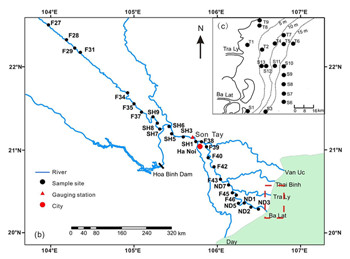红河沉积物粒度分选对磁性特征的影响及其环境意义
海洋、湖泊沉积物的磁性特征,通常作为代用指标用于古环境重建,因此,了解磁性特征的控制因素,是进行古环境重建的前提。来自河流的沉积物,在海洋中埋藏之前,经历了源汇过程中的粒度分选作用,其对磁性特征的影响值得探讨。本研究中,以红河的河流及水下三角洲沉积物为整体,进行了磁性特征空间变化的研究。研究结果表明,自河流上游到水下三角洲,随着粘土含量的增加,磁性颗粒变细,体现了沉积物磁性特征对粒度及水动力变化的响应,磁性参数χfd%、χARM等可作为粘土的代用指标。这一研究对在海洋沉积记录中利用磁性特征提取古环境信息具有重要意义。
Figure 1. The red rectangle in Figure 1b indicates the (c) inset map, in which the sampling sites in the subaqueous delta are shown.
Figure 3. Spatial variation of magnetic properties of the river bank and subaqueous sediments. The fluvial samples are arranged in order from upstream down to the coast. The subaqueous delta samples are grouped into shoreface (water depth <5 m) and prodelta (water depth >5 m) zones. The red lines depict the mean values either for the (d–f) river bank or the (a–c and g–i) prodelta sediments. (a and b) The river bank sediments have relatively high χ and SIRM values, suggesting higher ferrimagnetic mineral concentrations. Sediments from the prodelta have higher χfd%, χARM/χ, χARM/SIRM values (Figures 3d–3f), which suggests that the ferrimagnetic minerals become finer in the prodelta sediments.
相关成果在Geochemistry, Geophysics, Geosystems上发表,全文见:
-
GEOCHEMISTRY GEOPHYSICS GEOSYSTEMS ,
2016 ,
17(2)
: 270-281


